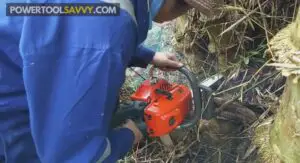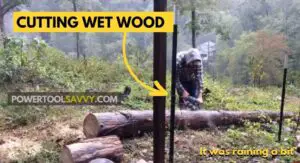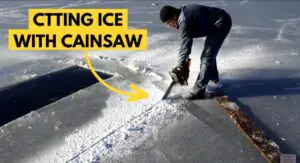Can you use a chainsaw in the rain?
You can use a gas-powered chainsaw in the rain, but you need to take some precautions to ensure your safety and minimize the risks. But, electric chainsaws are not ideal for use in the rain as they have electric components that can malfunction if exposed to water.
I did a little survey on our Facebook group, and it turns out that a whopping 93% of chainsaw folks don’t mind getting wet & using their saw in the rain!
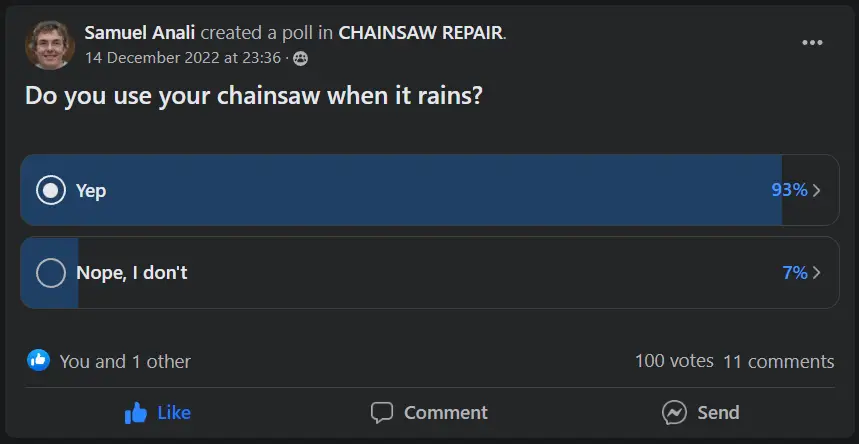
So, it’s very much doable; you just need to be a bit careful and well-prepared.
Don’t worry!
I’m Sam, and I have over two decades of experience working with chainsaws. I’ve used my chainsaw in extreme weather conditions, including heavy rain. 😎
In this article, I’m going to share everything you need to know about using a chainsaw in the rain. ⛈️
Let’s dive right in!
Table of Contents
ToggleIs it Safe to Use a Chainsaw in the Rain?
To be frank, the question we should ask isn’t whether you’re able to use a chainsaw in the rain, but rather if it’s SAFE to do so!
YES, you can run your chainsaw when it’s raining. It won’t cause any big issues for the saw itself, but it might pose certain hazards to you.
You see, using a chainsaw even in the “best” possible condition is dangerous. And when you add –
- slippery ground,
- unstable footing,
- the noise of rain pelting down on your hood,
- unpredictable winds,
- reduced visibility due to rain,
- and the weight of wet clothing & gear,
to the mix, it can become a recipe for disaster!
But wait, don’t lose hope just yet!
There are a few precautions that you can take to reduce the risks & make it a little less risky.
Safety Tips for Using a Chainsaw in the Rain
Well, here are a few tips that you can take to minimize the risks: 👇
Wear Your Safety Gear
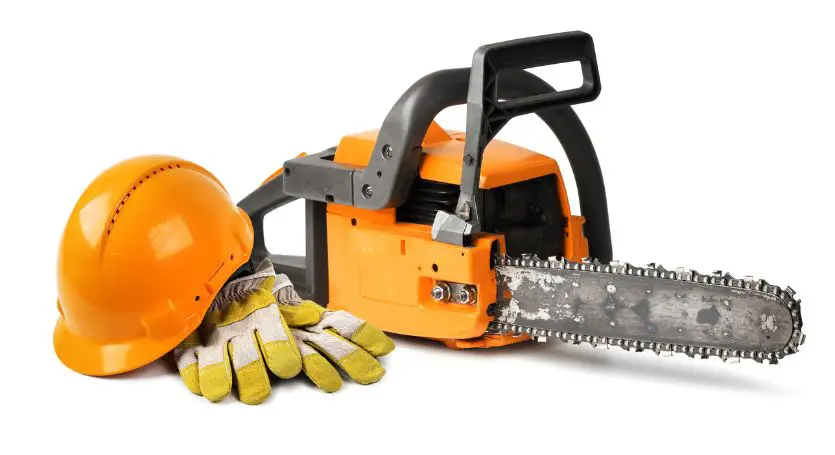
Wearing your safety gear is a must, no matter the weather conditions!
And when it comes to using a chainsaw in the rain, it becomes even more important. So, make sure you have your – 👇
- ✅ Gloves (avoid leather gloves as they may become slippery when wet. Instead, go for synthetic gloves with a good grip!)
- ✅ Waterproof jacket & chaps
- ✅ Safety goggles (trust me, water in your eyes is not fun!)
- ✅ Non-slip boots (again, avoid leather; go for rubber boots with good treads)
- ✅ Helmet (optional but recommended)
Prepare Your Saw Beforehand
Before you take your saw out in the rain, make sure it’s in good condition.
Here’s a QUICK checklist to follow: 👇
- ✅ Check your chain tension (make adjustments if needed).
- ✅ Make sure your saw is oiling.
- ✅ Make sure your chain is sharp (I recommend using a “fresh” chain that hasn’t had its teeth filed down way too far).
- ✅ Add bar & chain oil (if needed).
- ✅ Make sure the oil tank & fuel tank caps are tight.
- ✅ Warm up your saw before going out into the rain.
“Do I need to cover my saw?“
No, that’s not necessary. As I’ve mentioned before, chainsaws don’t actually have any issues running in the rain.
Don't Let the Air Filter Get Wet
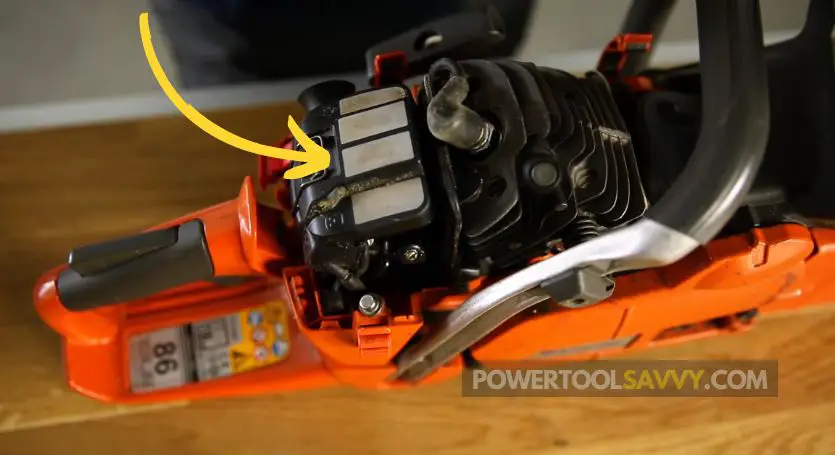
Well, if it’s raining heavily, you need to protect your saw’s air filter from getting wet.
Because once it’s too wet, the engine won’t get enough air, causing your saw to stall. Also, you may notice smoke coming out from the engine.
Make sure the back cover of your saw is securely in place so that water doesn’t get inside.
And in case your air filter does get wet, replace it with a dry one ASAP!
Clean the Work Area
If there’s a lot of mess around, it’s going to be even more challenging!
So, make sure that you clear out any obstacles, branches, or leaves from the work area to avoid slipping or tripping.
Plus, make sure you have an exit plan in case of an emergency (like a fallen tree, lightning, or a sudden gust of wind).
💡 PRO TIP: Remove the bark from the log you’re cutting into. Rain can cause some wood and bark to swell, increasing the likelihood of your chainsaw bar getting pinched!
Does Rain Affect the Performance of Your Chainsaw?
No, not really.
Plus, there’s a myth that cutting wet wood can dull your chain faster. But that’s not true.
In fact, if you ask me, cutting wet wood is easier as it’s softer and more pliable compared to dry wood.
On top of that, the moisture in it prevents the bar & chain from overheating.
So, performance-wise, you don’t have to worry about using a chainsaw in the rain. Just make sure you keep yourself safe!
Can You Submerge Your Chainsaw in Water?
NO!
Though chainsaws are designed to work in wet conditions, they aren’t waterproof. If you submerge your chainsaw, water can easily enter the carburetor and stall the engine.
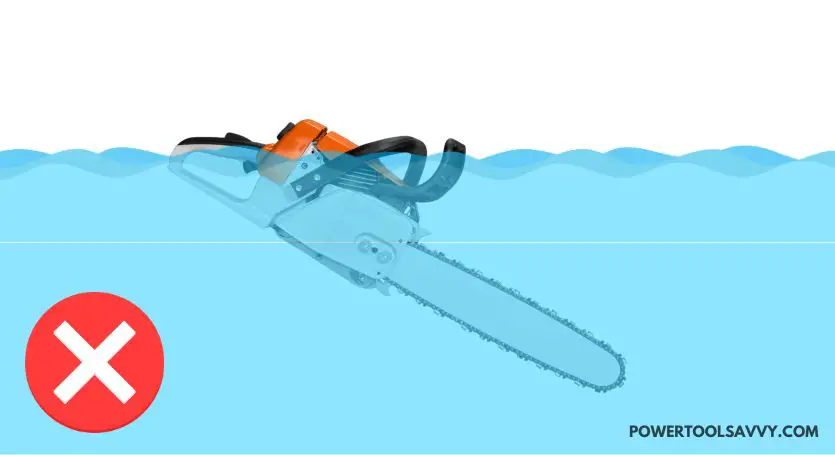
That’s not all!
Water can also enter into the fuel tank, causing more damage to the engine.
Even if you quickly take it out, the air filter will be wet, and your saw engine will run rich (since it’s getting too much fuel but not enough air). This can cause serious damage!
“But Sam, how do you cut wood submerged in water?“
Well, you can use a chainsaw to cut wood that’s underwater; just make sure the powerhead doesn’t get submerged. Only the bar should be in the water. (You can use a longer bar for this)
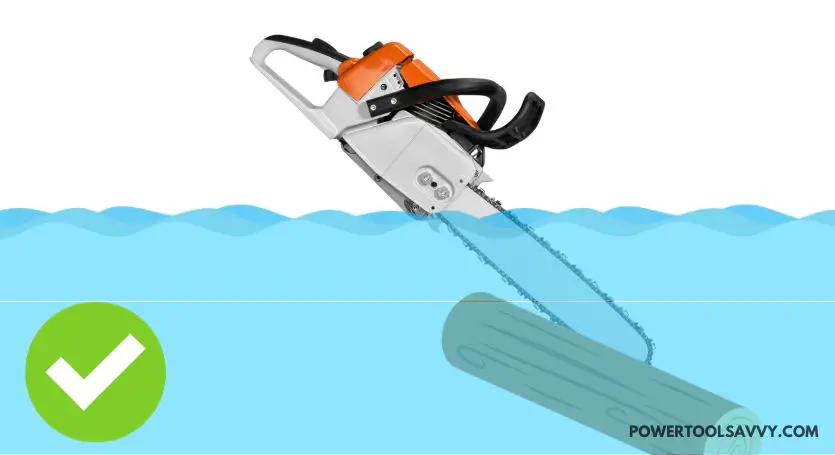
Can You Run an Electric Chainsaw in the Rain?
Electric chainsaws are not ideal for use in the rain. They are powered by electricity and have electric components (like the motor, battery, and switches) that can malfunction if exposed to water.
In addition to that, water is a good conductor of electricity, increasing the risk of “electrocution” much higher.
So, you should never use an electric chainsaw in the rain (let it be corded or cordless), even if it’s just drizzling.
It would not only void the warranty but also put you at risk of serious injury!
Maintenance After Using a Chainsaw in the Rain
Frankly speaking, gas-powered chainsaws don’t require any additional maintenance after being used in the rain.
Just leave it out to dry, wipe it down, and you’re good to go!
But here are a few things that I personally do to keep my saw in GOOD condition: 👇
- First of all, I take off the bar & chain and leave the saw on a towel to dry.
- Next, I clean the bar & chain (I use some WD-40 and a wire brush). I also grease the nose sprocket using a grease gun.
- When the saw is completely dry, I refill the oil tank and check if the saw is oiling correctly.
- Then I open the back cover and check the air filter. In case it’s wet or clogged up with dirt, I replace it with a new one.
- Lastly, I check the engine RPM and tune it if necessary.
And that’s pretty much it!

